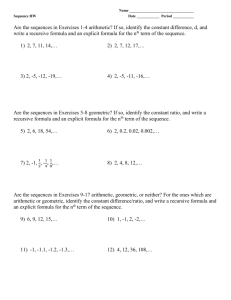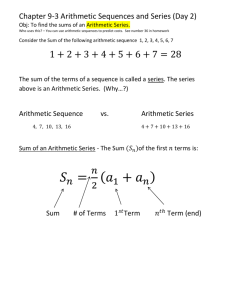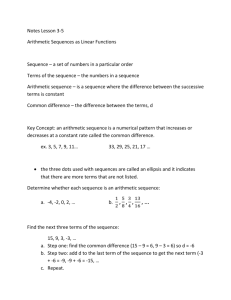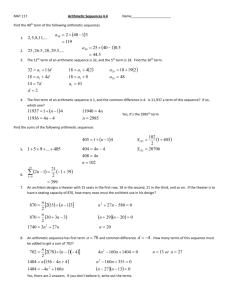3-5 Study Guide and Intervention
advertisement
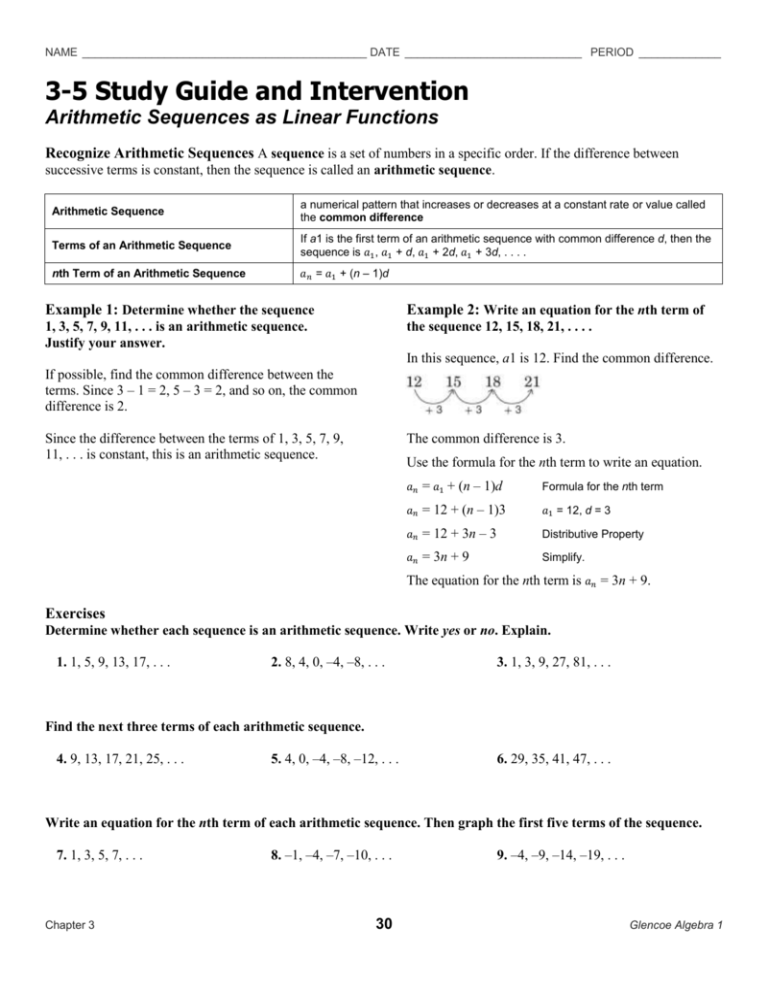
NAME _____________________________________________ DATE ____________________________ PERIOD _____________ 3-5 Study Guide and Intervention Arithmetic Sequences as Linear Functions Recognize Arithmetic Sequences A sequence is a set of numbers in a specific order. If the difference between successive terms is constant, then the sequence is called an arithmetic sequence. Arithmetic Sequence a numerical pattern that increases or decreases at a constant rate or value called the common difference Terms of an Arithmetic Sequence If a1 is the first term of an arithmetic sequence with common difference d, then the sequence is 𝑎1 , 𝑎1 + d, 𝑎1 + 2d, 𝑎1 + 3d, . . . . nth Term of an Arithmetic Sequence 𝑎𝑛 = 𝑎1 + (n – 1)d Example 1: Determine whether the sequence Example 2: Write an equation for the nth term of 1, 3, 5, 7, 9, 11, . . . is an arithmetic sequence. Justify your answer. the sequence 12, 15, 18, 21, . . . . In this sequence, a1 is 12. Find the common difference. If possible, find the common difference between the terms. Since 3 – 1 = 2, 5 – 3 = 2, and so on, the common difference is 2. Since the difference between the terms of 1, 3, 5, 7, 9, 11, . . . is constant, this is an arithmetic sequence. The common difference is 3. Use the formula for the nth term to write an equation. 𝑎𝑛 = 𝑎1 + (n – 1)d Formula for the nth term 𝑎𝑛 = 12 + (n – 1)3 𝑎1 = 12, d = 3 𝑎𝑛 = 12 + 3n – 3 Distributive Property 𝑎𝑛 = 3n + 9 Simplify. The equation for the nth term is 𝑎𝑛 = 3n + 9. Exercises Determine whether each sequence is an arithmetic sequence. Write yes or no. Explain. 1. 1, 5, 9, 13, 17, . . . 2. 8, 4, 0, –4, –8, . . . 3. 1, 3, 9, 27, 81, . . . Find the next three terms of each arithmetic sequence. 4. 9, 13, 17, 21, 25, . . . 5. 4, 0, –4, –8, –12, . . . 6. 29, 35, 41, 47, . . . Write an equation for the nth term of each arithmetic sequence. Then graph the first five terms of the sequence. 7. 1, 3, 5, 7, . . . Chapter 3 8. –1, –4, –7, –10, . . . 30 9. –4, –9, –14, –19, . . . Glencoe Algebra 1 NAME _____________________________________________ DATE ____________________________ PERIOD _____________ 3-5 Study Guide and Intervention (continued) Arithmetic Sequences as Linear Functions Arithmetic Sequences and Functions An arithmetic sequence is a linear function in which n is the independent variable, 𝑎𝑛 is the dependent variable, and the common difference d is the slope. The formula can be rewritten as the function 𝑎𝑛 = 𝑎1 + (n – 1)d, where n is a counting number. Example: SEATING There are 20 seats in the first row of the balcony of the auditorium. There are 22 seats in the second row, and 24 seats in the third row. a. Write a function to represent this sequence. The first term 𝑎1 is 20. Find the common difference. b. Graph the function. The rate of change is 2. Make a table and plot points. The common difference is 2. 𝑎𝑛 = 𝑎1 + (n – 1)d Formula for the nth term = 20 + (n – 1)2 𝑎1 = 20 and d = 2 = 20 + 2n – 2 Distributive Property = 18 + 2n Simplify. n 𝑎𝑛 1 20 2 22 3 24 4 26 The function is 𝑎𝑛 = 18 + 2n. Exercises 1. KNITTING Sarah learns to knit from her grandmother. Two days ago, she measured the length of the scarf she is knitting to be 13 inches. Yesterday, she measured the length of the scarf to be 15.5 inches. Today it measures 18 inches. Write a function to represent the arithmetic sequence. 2. REFRESHMENTS You agree to pour water into the cups for the Booster Club at a football game. The pitcher contains 64 ounces of water when you begin. After you have filled 8 cups, the pitcher is empty and must be refilled. a. Write a function to represent the arithmetic sequence. b. Graph the function. Chapter 3 31 Glencoe Algebra 1




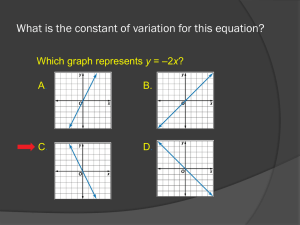
![Information Retrieval June 2014 Ex 1 [ranks 3+5]](http://s3.studylib.net/store/data/006792663_1-3716dcf2d1ddad012f3060ad3ae8022c-300x300.png)
